

Compact Muon Solenoid
LHC, CERN
| CMS-PAS-SUS-16-031 | ||
| Search for supersymmetry in events with at least one soft lepton, low jet multiplicity, and missing transverse momentum in proton-proton collisions at √s= 13 TeV | ||
| CMS Collaboration | ||
| October 2016 | ||
| Abstract: A search for supersymmetry with a compressed mass spectrum using events with high-momentum jet from initial state radiation, high missing energy, and a low-momentum lepton is presented. In particular, a scenario of top squark pair production is investigated, where the mass difference to the lightest supersymmetric particle (LSP) is smaller than the mass of the W boson. In this case the top squarks could undergo four-body decays to bff′+LSP. The search is performed in a sample of proton-proton collisions recorded with the CMS detector at a centre-of-mass energy of 13 TeV corresponding to an integrated luminosity of 12.9 fb−1. The results are consistent with the expectation from standard model processes and limits are set on the production cross section in the plane of the top squark vs. LSP masses. Assuming a 100% branching ratio of the four-body decay, top squark masses below 330 GeV are excluded at 95% confidence level for a mass difference to the LSP of about 25 GeV. The sensitivity of this search is similar to that of analyses targeting other final states in this region of supersymmetry parameter space with 2016 data. | ||
| Links: CDS record (PDF) ; inSPIRE record ; CADI line (restricted) ; | ||
| Figures | |

png pdf |
Figure 1:
Signal models for top squark pair production with subsequent four-body decays. Antiparticle labels are suppressed. |
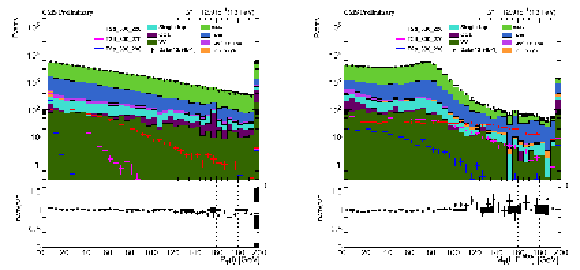
png pdf |
Figure 2:
Distributions of (left) lepton pT and (right) mT after the preselection. For each plot, the variable shown has been excluded from the selection. Data are indicated by circles. The uncorrected predicted background distributions from simulation are represented as filled, stacked histograms. The error bars and the dark, shaded bands indicate the statistical uncertainties of data and simulation, respectively. A few examples of signal distributions are shown as well. The lower panels show the ratio of data to the sum of the SM backgrounds. |

png |
Figure 2-a:
Distributions of lepton pT after the preselection. The variable shown has been excluded from the selection. Data are indicated by circles. The uncorrected predicted background distributions from simulation are represented as filled, stacked histograms. The error bars and the dark, shaded bands indicate the statistical uncertainties of data and simulation, respectively. A few examples of signal distributions are shown as well. The lower panel shows the ratio of data to the sum of the SM backgrounds. |
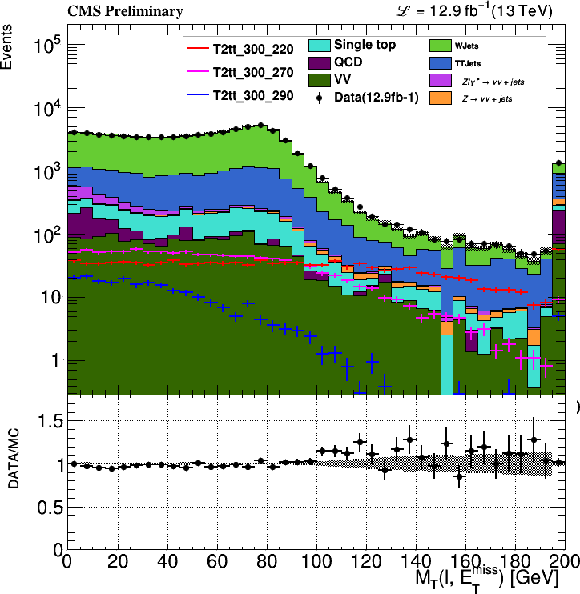
png |
Figure 2-b:
Distributions of mT after the preselection. The variable shown has been excluded from the selection. Data are indicated by circles. The uncorrected predicted background distributions from simulation are represented as filled, stacked histograms. The error bars and the dark, shaded bands indicate the statistical uncertainties of data and simulation, respectively. A few examples of signal distributions are shown as well. The lower panel shows the ratio of data to the sum of the SM backgrounds. |

png pdf |
Figure 3:
Summary of observed data and expected background yields in all signal regions. The shaded areas represent the combination of statistical and systematic uncertainties on background estimates. |
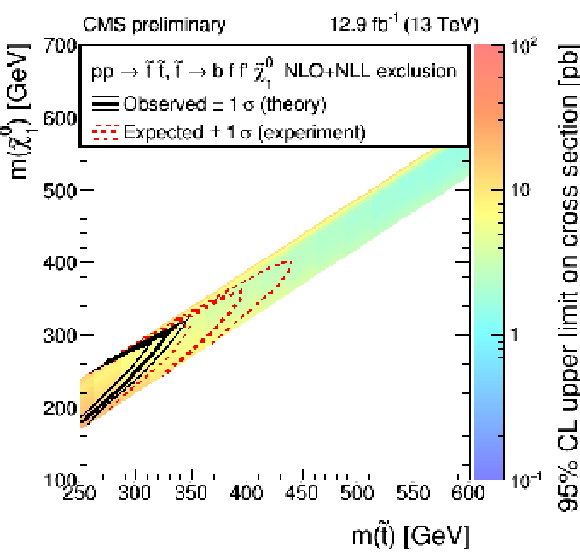
png pdf |
Figure 4:
Cross section and mass limits at 95% CL in the m(˜χ01) and m(˜t) mass plane. The colour shading corresponds to the observed limit on the cross section. The solid (dashed) lines show the observed (expected) mass limits, with the thick lines representing the central value and the thin lines the variations due to the theoretical (experimental) uncertainties. |
| Tables | |
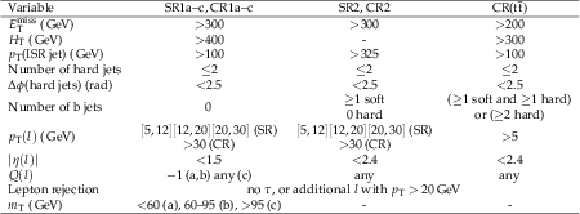
png pdf |
Table 1:
Definition of signal and control regions. For jets, the attributes ``soft'' and ``hard'' refer to the pT ranges 30-60 GeV and >60 GeV, respectively. For the calculation of the final results, each signal region (SR1a-c, SR2) is subdivided into three bins according to pT(l): 5-12, 12-20, and 20-30 GeV. |

png pdf |
Table 2:
Cut flow for background, data and signal samples. The lines above the first horizontal division correspond to preselection cuts, the middle section to cuts specific to SR1 and the last section to cuts specific to SR2. |

png pdf |
Table 3:
Contributions to the control regions as determined from simulation, together with the observed event counts. All uncertainties are statistical. |
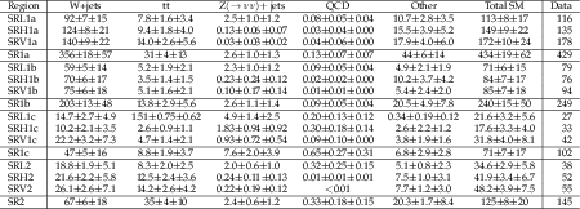
png pdf |
Table 4:
Summary of observed, and final expected background yields in the signal regions. The uncertainties on the background prediction are reported as ±(stat) ±(syst). |

png pdf |
Table 5:
Relative systematic uncertainties in % on the total background prediction in individual signal regions. The items in the first section of the table are assumed to be fully correlated among the SRs. |
| Summary |
| A search for supersymmetry with compressed mass spectra is performed in events with at least one soft lepton, moderate to high values of EmissT, and one or two hard jets, compatible with the emission of initial-state radiation. The data sample corresponds to 12.9 fb−1 of proton-proton collisions recorded by the CMS experiment at √s= 13 TeV. The target of this search is the pair production of top squarks with a mass splitting of at most 80 GeV with respect to the LSP. At small mass splitting, lepton momenta are low, and the b jets do not enter the acceptance. At higher values of Δm, the average lepton momentum increases and soft b jets can be reconstructed. Therefore, signal regions are divided depending on the presence or absence of a soft b-tagged jet and further sub-divided based on the the leading lepton pT. The transverse mass of the lepton-EmissT system is used as an additional discriminant. The main backgrounds to this search are W jets and tˉt production. Contributions to the signal regions from these and several nonleading background sources are estimated by using data in control regions to normalize the simulated yields. These estimates are tested with data in validation regions. The observations in the signal regions are compatible with the SM background predictions. In the absence of any indication of signal, cross section limits are set at 95% CL in the ˜t−˜χ01 mass plane. These results are used to extract mass limits based on a reference cross section for top squark pair production and assuming a 100% branching fraction for the four-body decay ˜t→bff′˜χ01. The sensitivity of this analysis exceeds that of previous single lepton searches [16,20] and is similar to the sensitivity obtained in searches with 2016 data in other final states [58,59]. |
| References | ||||
| 1 | J. Wess and B. Zumino | Supergauge transformations in four dimensions | Nucl. Phys. B 70 (1974) 39 | |
| 2 | R. Barbieri, S. Ferrara, and C. A. Savoy | Gauge models with spontaneously broken local supersymmetry | PLB 119 (1982) 343 | |
| 3 | H. P. Nilles | Supersymmetry, supergravity and particle physics | Phys. Reports 110 (1984) 1 | |
| 4 | H. E. Haber and G. L. Kane | The search for supersymmetry: Probing physics beyond the standard model | Phys. Reports 117 (1985) 75 | |
| 5 | S. Dawson, E. Eichten, and C. Quigg | Search for supersymmetric particles in hadron-hadron collisions | PRD 31 (1985) 1581 | |
| 6 | E. Witten | Dynamical breaking of supersymmetry | Nucl. Phys. B 188 (1981) 513 | |
| 7 | S. Dimopoulos and H. Georgi | Softly broken supersymmetry and SU(5) | Nucl. Phys. B 193 (1981) 150 | |
| 8 | G. R. Farrar and P. Fayet | Phenomenology of the production, decay, and detection of new hadronic states associated with supersymmetry | PLB 76 (1978) 575 | |
| 9 | R. Barbieri and G. Giudice | Upper bounds on supersymmetric particle masses | Nucl. Phys. B 306 (1988) 63 | |
| 10 | B. de Carlos and J. Casas | One-loop analysis of the electroweak breaking in supersymmetric models and the fine-tuning problem | PLB 309 (1993) 320 | hep-ph/9303291 |
| 11 | M. Dine, W. Fischler, and M. Srednicki | Supersymmetric technicolor | Nucl. Phys. B 189 (1981) 575 | |
| 12 | S. Dimopoulos and S. Raby | Supercolor | Nucl. Phys. B 192 (1981) 353 | |
| 13 | N. Sakai | Naturalness in supersymmetric GUTS | Z. Phys. C 11 (1981) 153 | |
| 14 | R. K. Kaul and P. Majumdar | Cancellation of quadratically divergent mass corrections in globally supersymmetric spontaneously broken gauge theories | Nucl. Phys. B 199 (1982) 36 | |
| 15 | C. Bal\'azs, M. Carena, and C. E. M. Wagner | Dark matter, light stops and electroweak baryogenesis | PRD 70 (2004) 015007 | hep-ph/0403224 |
| 16 | CMS Collaboration | Search for supersymmetry in events with soft leptons, low jet multiplicity, and missing transverse energy in proton anti-proton collisions at √s= 8 TeV | PLB759 (2016) 9--35 | CMS-SUS-14-021 1512.08002 |
| 17 | CMS Collaboration | Searches for third-generation squark production in fully hadronic final states in proton-proton collisions at √s= 8 TeV | JHEP 06 (2015) 116 | CMS-SUS-14-001 1503.08037 |
| 18 | ATLAS Collaboration | Search for top squark pair production in final states with one isolated lepton, jets, and missing transverse momentum in √s= 8 TeV pp collisions with the ATLAS detector | JHEP 11 (2014) 118 | 1407.0583 |
| 19 | ATLAS Collaboration | Search for pair-produced third-generation squarks decaying via charm quarks or in compressed supersymmetric scenarios in pp collisions at √s= 8 TeV with the ATLAS detector | PRD 90 (2014) 052008 | 1407.0608 |
| 20 | CMS Collaboration Collaboration | Search for new physics in the one soft lepton final state using 2015 data at √s= 13 TeV | CMS-PAS-SUS-16-011 | CMS-PAS-SUS-16-011 |
| 21 | CMS Collaboration | The CMS experiment at the CERN LHC | JINST 3 (2008) S08004 | CMS-00-001 |
| 22 | CMS Collaboration | Particle--Flow Event Reconstruction in CMS and Performance for Jets, Taus, and EmissT | CDS | |
| 23 | CMS Collaboration | Commissioning of the Particle-flow Event Reconstruction with the first LHC collisions recorded in the CMS detector | CDS | |
| 24 | M. Cacciari, G. P. Salam, and G. Soyez | The anti-kt jet clustering algorithm | JHEP 04 (2008) 063 | 0802.1189 |
| 25 | CMS Collaboration | Jet Performance in pp Collisions at 7 TeV | CDS | |
| 26 | CMS Collaboration | Jet energy scale and resolution in the 8 TeV pp data | ||
| 27 | CMS Collaboration | Performance of the CMS missing transverse momentum reconstruction in pp data at √s= 8 TeV | JINST 10 (2015) P02006 | CMS-JME-13-003 1411.0511 |
| 28 | CMS Collaboration | Identification of b-quark jets with the CMS experiment | JINST 8 (2013) P04013 | CMS-BTV-12-001 1211.4462 |
| 29 | CMS Collaboration | Performance of b tagging at √s= 8 TeV in multijet, tˉt and boosted topology events | CMS-PAS-BTV-13-001 | CMS-PAS-BTV-13-001 |
| 30 | CMS Collaboration | Performance of τ-lepton reconstruction and identification in CMS | JINST 7 (2012) P01001 | CMS-TAU-11-001 1109.6034 |
| 31 | CMS Collaboration | Performance of electron reconstruction and selection with the CMS detector in proton-proton collisions at √s= 8 TeV | JINST 10 (2015) P06005 | CMS-EGM-13-001 1502.02701 |
| 32 | CMS Collaboration | Performance of CMS muon reconstruction in pp collision events at √s= 7 TeV | JINST 7 (2012) P10002 | CMS-MUO-10-004 1206.4071 |
| 33 | S. Frixione, P. Nason, and C. Oleari | Matching NLO QCD computations with parton shower simulations: the POWHEG method | JHEP 11 (2007) 070 | 0709.2092 |
| 34 | T. Sjostrand, S. Mrenna, and P. Skands | PYTHIA 6.4 physics and manual | JHEP 05 (2006) 026 | hep-ph/0603175 |
| 35 | T. Sjostrand, S. Mrenna, and P. Z. Skands | A Brief Introduction to PYTHIA 8.1 | CPC 178 (2008) 852--867 | 0710.3820 |
| 36 | J. Alwall et al. | The automated computation of tree-level and next-to-leading order differential cross sections, and their matching to parton shower simulations | JHEP 07 (2014) 079 | 1405.0301 |
| 37 | GEANT4 Collaboration | GEANT4---a simulation toolkit | NIMA 506 (2003) 250 | |
| 38 | CMS Collaboration | The fast simulation of the CMS Detector at LHC | J. Phys. Conf. Ser. 331 (2011) 032049 | |
| 39 | CMS Collaboration | Measurement of the polarization of W bosons with large transverse momenta in W+Jets events at the LHC | PRL 107 (2011) 021802 | CMS-EWK-10-014 1104.3829 |
| 40 | ATLAS Collaboration | Measurement of the polarisation of W bosons produced with large transverse momentum in pp collisions at √s= 7 TeV with the ATLAS experiment | EPJC 72 (2012) 2001 | 1203.2165 |
| 41 | Z. Bern et al. | Left-handed W bosons at the LHC | PRD 84 (2011) 034008 | 1103.5445 |
| 42 | T. Junk | Confidence level computation for combining searches with small statistics | NIMA 434 (1999) 435 | hep-ex/9902006 |
| 43 | A. L. Read | Presentation of search results: the CLs technique | JPG 28 (2002) 2693 | |
| 44 | ATLAS and CMS Collaborations, LHC Higgs Combination Group | Procedure for the LHC Higgs boson search combination in Summer 2011 | Technical Report ATL-PHYS-PUB/2011-11, CMS NOTE 2011/005 | |
| 45 | CMS Collaboration | CMS luminosity based on pixel cluster counting - summer 2013 update | CMS-PAS-LUM-13-001 | CMS-PAS-LUM-13-001 |
| 46 | S. Alekhin et al. | The PDF4LHC working group interim report | 1101.0536 | |
| 47 | M. Botje et al. | The PDF4LHC working group interim recommendations | 1101.0538 | |
| 48 | NNPDF Collaboration | Parton distributions with LHC data | Nucl. Phys. B 867 (2013) 244 | 1207.1303 |
| 49 | A. D. Martin, W. J. Stirling, R. S. Thorne, and G. Watt | Parton distributions for the LHC | EPJC 63 (2009) 189 | 0901.0002 |
| 50 | H.-L. Lai et al. | New parton distributions for collider physics | PRD 82 (2010) 074024 | 1007.2241 |
| 51 | CMS Collaboration | Search for top-squark pair production in the single-lepton final state in pp collisions at √s= 8 TeV | EPJC 73 (2013) 2677 | CMS-SUS-13-011 1308.1586 |
| 52 | W. Beenakker, R. Hopker, M. Spira, and P. M. Zerwas | Squark and gluino production at hadron colliders | Nucl. Phys. B 492 (1997) 51 | hep-ph/9610490 |
| 53 | A. Kulesza and L. Motyka | Threshold resummation for squark-antisquark and gluino-pair production at the LHC | PRL 102 (2009) 111802 | 0807.2405 |
| 54 | A. Kulesza and L. Motyka | Soft gluon resummation for the production of gluino-gluino and squark-antisquark pairs at the LHC | PRD 80 (2009) 095004 | 0905.4749 |
| 55 | W. Beenakker et al. | Soft-gluon resummation for squark and gluino hadroproduction | JHEP 12 (2009) 041 | 0909.4418 |
| 56 | W. Beenakker et al. | Squark and gluino hadroproduction | Int. J. Mod. Phys. A 26 (2011) 2637 | 1105.1110 |
| 57 | M. Kramer et al. | Supersymmetry production cross sections in pp collisions at √s= 7 TeV | 1206.2892 | |
| 58 | CMS Collaboration Collaboration | Search for new physics in the compressed mass spectra scenario using events with two soft opposite-sign leptons and missing momentum energy at 13 TeV | CMS-PAS-SUS-16-025 | CMS-PAS-SUS-16-025 |
| 59 | CMS Collaboration Collaboration | Search for direct top squark pair production in the fully hadronic final state in proton-proton collisions at √s= 13 TeV corresponding to an integrated luminosity of 12.9 fb−1 | CMS-PAS-SUS-16-029 | CMS-PAS-SUS-16-029 |

|
Compact Muon Solenoid LHC, CERN |

|

|

|

|

|

|